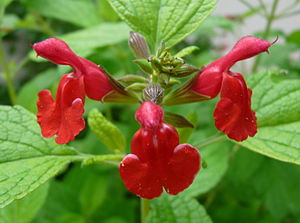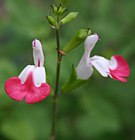Note: This is a project under development. The articles on this wiki are just being initiated and broadly incomplete. You can Help creating new pages.
Salvia microphylla - Baby sage
Salvia microphylla is a perennial shrub found in the wild in southeastern Arizona and the mountains of eastern, western, and southern Mexico. It is a very complex species which easily hybridizes, resulting in numerous hybrids and cultivars brought into horticulture since the 1990s.
Uses
Parts Used
Chemical Composition
1‐diphenyl‐2‐picrylhydrazyl (DPPH) and β‐carotene/linoleic acid tests were used to determine the antioxidant activity. Terpin‐4‐ol (14.95%), sabinene (13.07%) and γ‐terpinene (11.22%) were found to be the major constituents in the essential oil of M. fragrans by gas chromatography, whereas (E)‐caryophyllene (15.35%), α‐eudesmol (14.06%), β‐eudesmol (8.74%) and γ‐eudesmol (7.64%) were encountered in the essential oil of S. microphylla.[1]
Common names
| Language | Common name |
|---|---|
| Kannada | |
| Hindi | |
| Malayalam | |
| Tamil | |
| Telugu | |
| Marathi | NA |
| Gujarathi | NA |
| Punjabi | NA |
| Kashmiri | NA |
| Sanskrit | |
| English | Baby sage |
Properties
Reference: Dravya - Substance, Rasa - Taste, Guna - Qualities, Veerya - Potency, Vipaka - Post-digesion effect, Karma - Pharmacological activity, Prabhava - Therepeutics.
Dravya
Rasa
Guna
Veerya
Vipaka
Karma
Prabhava
Habit
Identification
Leaf
| Kind | Shape | Feature |
|---|---|---|
| Deciduous | Needled |
Flower
| Type | Size | Color and composition | Stamen | More information |
|---|---|---|---|---|
| bisexual | 2.5 cm long | White, Multi-Color | 5-6 | Flower Time is Late spring or early summer |
Fruit
| Type | Size | Mass | Appearance | Seeds | More information |
|---|---|---|---|---|---|
| short legume | 7.5–11 cm long, 1.5 cm broad | 12-20 seeds | {{{5}}} | {{{6}}} |
Other features
List of Ayurvedic medicine in which the herb is used
Where to get the saplings
Mode of Propagation
How to plant/cultivate
A plant usually of higher elevations in the tropics, occasionally descending as low as 1,200 metres. [3]
Commonly seen growing in areas
Photo Gallery
References
External Links
- Ayurvedic Herbs known to be helpful to treat fever
- Herbs with Roots used in medicine
- Herbs with Bark used in medicine
- Herbs with Leaves used in medicine
- Herbs with common name in English
- Habit - Evergreen Perennial shrub
- Index of Plants which can be propagated by Seeds
- Index of Plants which can be propagated by Cuttings
- Herbs that are commonly seen in the region of beds Wall-side Borders City
- Herbs that are commonly seen in the region of Flower borders side Borders City
- Herbs that are commonly seen in the region of Coastal Cottage
- Herbs
- Lamiaceae


